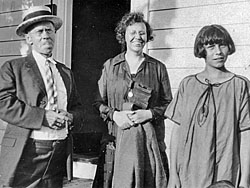

A Visit to Caroline Porter Kier
by Bert Willard
The day after the convention I drove to Bar Harbor, Maine to catch up with my family already on vacation. On the way I stopped in Port Clyde to pay a visit to Caroline Kier, whom I have not seen for numerous years. She is Russell Porter's daughter and only living descendent. She lives next door to the old Porter homestead, where Russell settled down after his Arctic explorations and before W.W.I. That is where he first erected a polar telescope sticking out of the roof of his house, using 16-inch mirrors, -- the same ones which were later put in the Porter Turret at Stellafane.

in front of their home in
Springfield, Vermont.
Caroline said she was overjoyed to see me, not because I'm me, but because she had some things she wanted to give me for the museum. After a cup of coffee she led me into the living room and said, "Now Bert, look over the things on the bookshelves and take anything you want. I want them to have a good home and if you don't take them they will be just auctioned off some day."
That is not the exact wording, but it is the message. I was like a little kid in a candy store with a fist full of quarters to spend. All these things could end up in our museum? I wasn't sure how to respond. I didn't feel right in taking the things that have been part of her life for so long. But we got boxes and newspapers and after I reverently pulled a model of the 200-inch dome from the shelf, Caroline wrapped and placed it in a box. A metal handle which Porter pitched to the back of grinding tools, a model of an early version of the 200-inch telescope, a small window mounted solar clock, -- these are some of the items which attracted my eye. There were many books, some signed by the authors, some by Porter, ranging from his Arctic adventures to Palomar I accepted most of them. There were also many historical documents, like the dedication ceremony to the 200-inch telescope, Porter's honorary doctorate diploma from Norwich University, and newspaper and magazine articles about Porter.
The last item that caught my eye touched me the most. On the bottom shelf was a small telescope with a 3-inch diameter black tube. Upon inquiring, Caroline told me she had made the mirror when she was 12 years old and her father made the rest. Her father would instruct her on how to rub the 2 an 1/2 inch pieces of glass together around the barrel, and what to do at each step. That was when they lived at 2 Hill Place in Springfield, which incidentally is where my in-laws now live. I looked through the tiny eyepiece and out the window at the trees. It still performed nicely. I could tell Caroline was having a hard time parting with this. I never knew that she and her father had ever made a telescope together.
Caroline Porter Kier departed us in November of 1995. She was a full member of the Springfield Telescope Makers, having made her own mirror under her father's supervision back when she was 12 years old. Her completed telescope resides in the museum at the Hartness House along with many other Porter artifacts which she donated. The 1996 Stellafane Convention was dedicated to the memory of Caroline Porter Kier during the evening awards ceremony.
Maryann Arrien
The rest of the living room is filled with original Porter artwork, most of which I had seen many years before while doing the research for his biography. The 5-foot high stained-glass picture of the America frozen in the Arctic ice has since been returned next door to The Castle. This is a stone guest house which Porter built, which has been restored and added to by an artist who is very much interested in Porter and Astronomy. He even has 2-3 telescopes in his barn gallery and he enjoys taking his kids out observing. He knew about Stellafane.
So now I have the task of organizing all the items I brought home and planning how they should be displayed and archived in our museum. I came away with more than just a few boxes in the back of the car. During our conversation little things kept coming out that I had never heard. For example, Caroline told me that when the early members were building Stellafane in 1924, her father told her to make a time capsule by placing her name, the date and a small message in a tin can and placing it in the west wall of the living room. It should still be there.
Back to the Early History Page